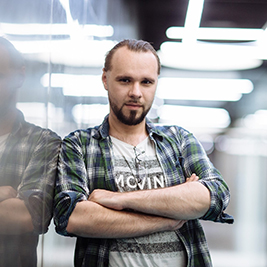Bank of Portraits / Pastukh Hlykeria and Pavlo

Pastukh Hlykeria and Pavlo
The Pastukh family lived in the village of Kryvukha, Rivne region. Pavlo and Hlykeria engaged in agriculture, and their five children assisted them. The hard life of the peasant family became even harder after the outbreak of the German-Soviet war. Already on June 25, 1941, Dubno and the neighboring settlements were seized by the German and Hungarian troops. The occupiers forced the peasants to give them part of their products.
The Nazis began persecution of the local Jewish community, which was one of the largest in the region. Before the war only in the town of Dubno approximately 7,000 Jews lived, and in 1939-1941 they were joined by the numerous refugees from the Polish territories, occupied by the German and Soviet troops. Many Jews lived in the small towns. In many of them the Jewish part reached up to half of the total population.
The Nazis had their own vision of the region’s future. Dubno and the neighboring settlements shaped the Dubno gebiet – the territorial unit in the General District “Vohlynia-Podillia” with Rowno as the center, which had also to be the ‘capital’ of the Reichskommissariat “Ukraine”. That is why the occupiers paid much attention to “purification” of the region from the “unwished” elements. Before the expulsion of the Nazis in 1944, formerly numerous Jewish community was exterminated almost completely.
The “liquidation actions” started in the town of Dubno and the villages nearby. In July and August 1941, the mass reprisals by the German troops and the auxiliary police had place throughout this district. Approximately 1,000 local Jews became their victims. The confiscation of valuables, expensive clothes, cattle, bicycles and other things started.
In April 1942, the ghettos were established in the number of the settlements (Dubno, Kostopil, Mizoch, Derazhne etc.). The “Judenrat” was appointed in the ghetto of Dubno. The ghetto was encircled by the tall wooden fence and the barbed wire. Leaving it was possible only by the special yellow mark on the clothes. Even inside this place, the Nazis tried to separate people, who were united by grief: in the one part of the ghetto they settled the craftsmen and qualified workers with their families, and another one was designated for women, children and those considered ‘useless’. Nearly 15,000 persons from Dubno and the neighborhood became the ghetto prisoners.

The first large-scale execution of the Jews from the Dubno ghetto happened on May 27, 1942, when nearly 7,000 persons, recognized as the ‘incapable’, were shot dead outside the town. Before the death they were separated again: the men were sent for execution to the place called Shybyna Hora, while women and children – to the village of Surmychi on the outskirts of Dubno. The rest of the Jews were murdered in the autumn of the same year during the ghetto liquidation. Very few of them survived: some of them found a hideout in the ghetto, others managed to escape on the way to the shooting site.
Among the survivors was the woman named Henia Maler and her children Fania and Ephraim. They were 15 and 12 years old. For a while, they had been roaming around the neighborhoods, living in the forest, but went to the village of Kryvukha when it became cold. The peasants fed the escapees, but nobody dared to harbor them. Nevertheless, the peasants advised Henia to hide in the abandoned barn. In this way the Malers family received the minimal roof above head, but this hideout was not safe: the barn was in the open space and it was easy to notice people inside. Moreover, many people in Kryvukha knew about the escapee from the Dubno ghetto.
Once Hlykeria Pastukh brought Henia the pouch with food. Henia already knew: the Germans heard the rumors that she was hiding in the village, and their arrival was just the question of time.
Henia begged Hlykeria to harbor them. After speaking to her husband, the woman agreed. Pavlo Pastukh with his senior son Dmytro prepared the hideout for the woman and her children in the attic of the barn, where the escapees hid until the frost began. Then Pavlo made the new hideout for them: he dug the pit in the barn and covered it with wooden boards.
Until the final expulsion of the occupiers from the region, the Pastukh family kept in secret the fact of sheltering the ghetto escapees. In the cold season, Henia, Fania and Ephraim hid in the barn, in the calm and warm periods went to the barn attic. To prevent the suspicions among the neighbors, children brought the food for the Jews as the food for cattle, putting the pot with a meal inside the bucket. Even after Pavlo and the senior daughter Maria were deported to Germany as the forced laborers, the family continued to shelter the escapee, supporting her and putting faith in the soon liberation.
On March 17, 1944, the 1st Ukrainian Front expelled the Nazis from the town of Dubno. Therefore, Henia and her children came back to their house. She spent 18 long months in the Pastukhs’ house. After the war they lost connection for many years. Henia, Fania and Ephraim went to Poland, then migrated to Israel. Only in 2008, Ephraim came back to Ukraine and found the children and grandchildren of Pavlo and Hlykeria Pastukh.
On August 1, 2010, Pavlo and Hlykeria Pastukh were posthumously honored as the Righteous Among the Nations. The diploma and medal were handled to their descendant Ihor Kondratiev.

Maksym Milevskyi
Kyiv
The National Museum of the History of Ukraine in the Second World War
-
fingerprintArtefacts
-
theatersVideo
-
subjectLibrary


